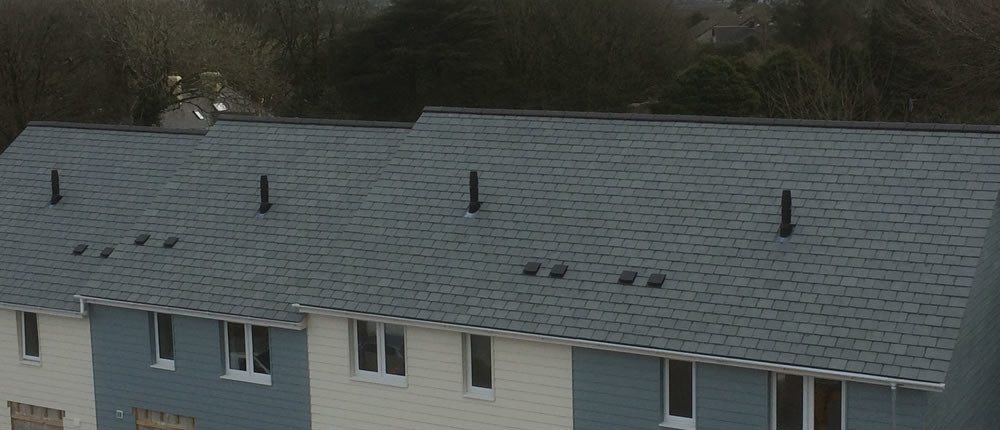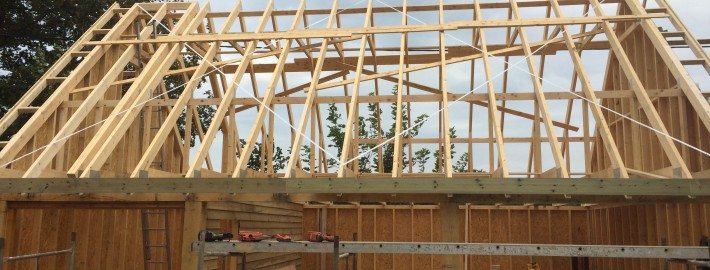5 Best Roofing Materials for New Builds
When building a new home, the roof is going to be one of the most dominant features of the property, and one which will take a good deal of planning to get right. When planning which roofing materials are best for a new build, so many factors need to be considered including unit cost, insulation, design and the eco-credentials of your chosen roofing solution.
It’s crucial that each aspect of the roof material is assessed at the planning stages of building a new home to ensure that your new home is warm and watertight, looks beautiful and keeps your home securely protected for many years to come. For renovation projects or builds in areas of outstanding natural beauty, the historical integrity of a roof must also be considered.
Some types of roofing may be better suited for your new build than others. Factors such as the slope of the roof and strength of the framing could limit your choices, and the type of roof tile chosen will strongly influence the aesthetic look you achieve (and of course the final cost too!) Typically, the roof structure should cost around 10 per cent of your entire build cost (depending on complexity) and its covering about five per cent, although this will vary depending on the materials. From flat roofing to modern zinc roofing, here at Giant Roofing we offer a wide range of quality roofing solutions to protect our customers and their homes. Here we explore the five best roofing materials for new builds to take the devil out of the detail and make it easy for you to plan. You’re welcome!

Which Roofing Materials are Best for a New Build?
1) Slate Roofing
Slating is a natural product which is extremely durable and hard-wearing and adds a luxurious touch to your home. A slate roof requires a pitch of 30 degrees, and needs significant overlapping on several sides to ensure your new roof is watertight. Slate tiles must be laid on battens over an underlay, and finished with clay or metal at the roof junctions and ridges. British slates such as Welsh slate is considered ‘the best’ but usually commands top-end prices as you’d expect. If you’re considering using manmade slate tiles on your new build home, you’ll find that they do not age like their natural counterparts (and are unlikely to last centuries, like Welsh slate for example), but the lower cost of manmade slate is usually the big attraction. Slate roofing tiles offer a wealth of choices and are available in a range of sizes and thicknesses, as well as a wide range of colours and styles.
2) Concrete Roofing
A popular and much-used roofing material, concrete roof tiles interlock, offering improved waterproofing, secure fixing and shallower roof pitches. The possibilities with concrete roof tiles are virtually limitless. Concrete is also very competitive price-wise which is what makes it one of the best roofing materials for new builds. Modern concrete roof tiles are made from cement, graded sands and pigments and formed into a number of distinctive tile designs, which makes the, a very lightweight and attractive roofing option. The versatility of concrete roofing solutions is a big draw for many self-builds and, once properly installed, a concrete roof requires very little maintenance for the life of the roof. Approximately 10 concrete tiles are needed per square metre which makes them less expensive than clay tiles.
3) Clay Tiles
Clay tile roofing is one of the oldest and most commonly used roofing material in the world. Great for curves and for creating intricate details, clay tiles come in a range of colours and shapes, with special tiles for valleys, ridges and gulleys. Clay roof tiles can last for many decades, much longer than many other roofing materials, and they require little maintenance to remain in good condition. Clay tiles for new builds are a great option as they have a long lifespan and are resistant to fire, frost and wind. Clay has reflective properties, which help to increase the efficiency of heating and cooling systems for your new build home. Clay roof tiles are not susceptible to mould or rot and do not shrink and expand with extreme temperature fluctuations. If using this roofing material for a new build, you need to be sure that your roof can support the weight, so you may need to add support beams before beginning installation. Clay roofing tiles have a good second-hand market, making them fairly sustainable and easy to pick up for a little more reasonable in price than new clay tiles.
4) Metal Roofing
When considering using metal roofing for your home it seems like a modern solution, but copper roofing has been a roofing choice for generations on churches and domes. Metal roofs are surprisingly lightweight and are great at reflecting heat from the sun, a characteristic that helps homeowners save energy on cooling bills (and may even qualify for tax credits!). Metal roofing can be supplied in a wide range of looks and finishes, from domestic housing through to commercial property needs. Metal roofs are favoured for their fire-resistant qualities, longevity, and speed of installation so if you’re trying to complete a build to a short deadline, metal roofing is a good option. Depending on the roofing material used, metal roofs not only have 25-95% recycled content, but are also 100% recyclable at the end of their life as a roof meaning that they are a good ecologically-friendly roofing option for your new build. Lead roofing has been proven to be one of the greenest roofing materials available, and lasts three times longer than other man-made products.
5) A Flat Roof
More commonly used for garages, offices and commercial buildings, flat roofing historically used tar or asphalt applied over roof decking to keep the building underneath dry, warm and watertight. These days, liquid applied systems such as fibreglass and EPDM flat roofing are widely used in flat roofing in Cornwall and all over the UK. Because of these advances in technology, the flat roof seems to be moving to centre stage and is fast-becoming a popular roofing material for new builds, especially with the trend for cool modern structures and the growing interest in green roofs. One of the main advantages of using a flat roof is that it frees up internal space and you have more freedom to plan interesting shapes beneath a flat roof without having to worry about the way the roof is held up. Flat roofs are still cheaper to construct than pitched roofs and need less material to cover the same span. Flat roofs can also be installed on new builds to create suntrap BBQ spots and roof garden spaces for a home where outdoors space may be otherwise limited.
Choosing the best roofing materials for a new build is easy. Simply ask a specialist roofing contractor such as Giant Roofing to visit the site and provide a free quotation based on your specification and requirements. Giant Roofing is a roofing company in Cornwall specialising in all types of roof installation and maintenance; a professional roofing specialist with over 20 years’ experience.
Please get in touch today to ask our expert team for a free roofing quote.




Leave a Reply
Want to join the discussion?Feel free to contribute!